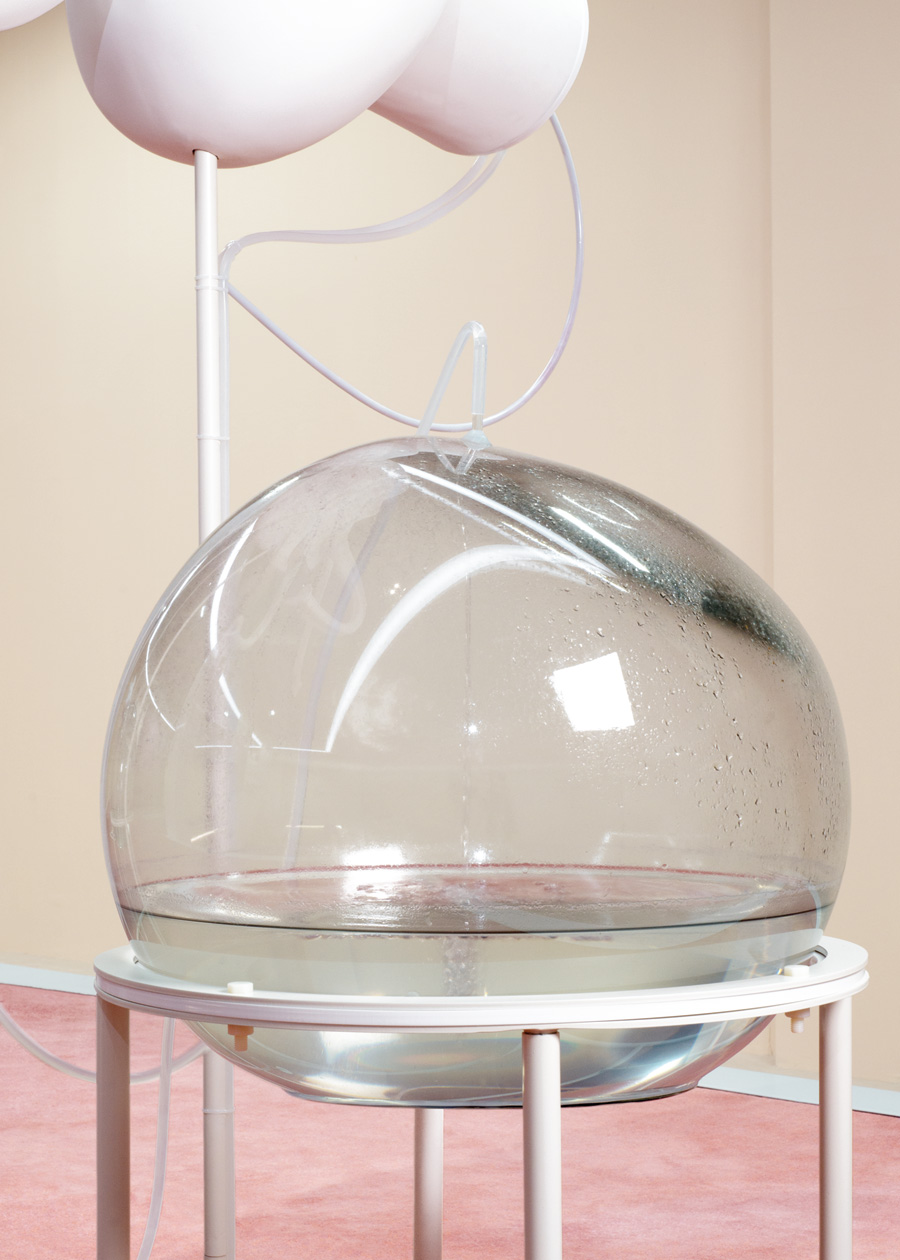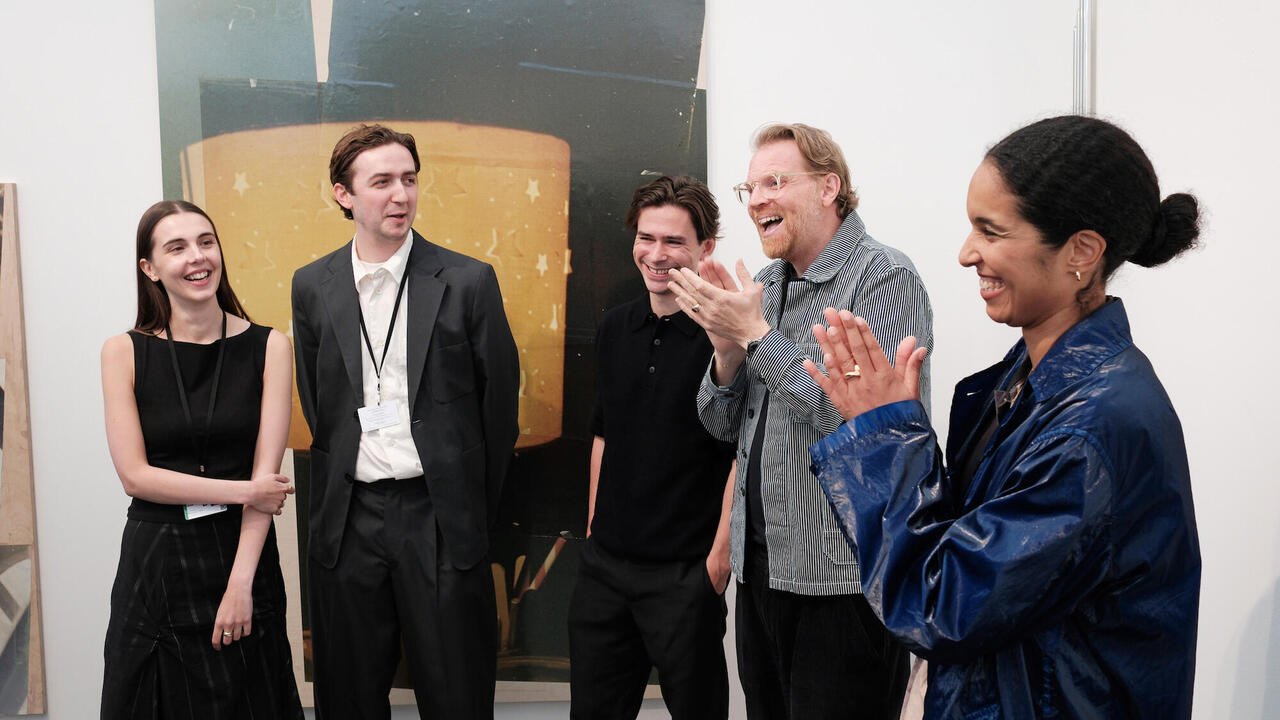Mysteries & Methodologies
Marguerite Humeau's exhibition 'FOXP2', now open at Nottingham Contemporary, proposes imaginative responses to unanswerable questions
Marguerite Humeau's exhibition 'FOXP2', now open at Nottingham Contemporary, proposes imaginative responses to unanswerable questions

In the scene preceding the iconic images of a tossed bone and tumbling space station in Stanley Kubrick’s 2001: A Space Odyssey (1968), the simian antecedents of interplanetary humanity discover a black monolith. Their encounter with the monument, deposited on earth by an alien intelligence, triggers the evolutionary shift into a higher order of species. A bone is reconceived as a tool; sound shifts into language. Monkey becomes man and, soon enough, we’re floating in space.

Marguerite Humeau’s exhibition earlier this year, ‘FOXP2’ at the Palais de Tokyo in Paris (realized with scenographer Juliette Rambaud and on view this month, in a new configuration, at Nottingham Contemporary), executed a comparably audacious transition between remote scenarios in space and time. Curated by Rebecca Lamarche-Vadel, the show began in a dark passageway around which echoed a chorus of inchoate but recognizably humanoid whoops and hollers. This led to a curtained threshold, through which you stepped into a dazzlingly bright room stocked with futuristic sculptures: like Kubrick’s millennia-spanning edit, this abrupt shift signalled a metaphysical, as much as a literal, enlightenment with the cross-scene continuity provided by the substitution of one set of animal sounds for another. The twist is that Humeau’s imagined future is populated not by advanced humans, but by a small herd of highly evolved elephants. Realized in a combination of artificial and organic materials (including, in one case, polystyrene, latex, silicone, nylon, glass vial, hormone powder and elephant tears), these unearthly beings are showcased on a raised dais carpeted in pink mist. As their trumpets resound around the room, you are prompted to wonder what came to pass in the period elided by the move from one space into another.
The walls of Humeau’s studio in northeast London are crowded with elaborate diagrams, colour swatches and preparatory sketches that might – if they could ever be decoded – provide an answer to that question. At intervals throughout our conversation, the artist unpinned a sheet from the wall, repurposing it as a visual illustration of the processes underpinning her projects, which she describes as ‘explorations into what might have been’. The conditional tense can signify two different things: that which we know to have happened, but precise knowledge of which is denied to us (what the earliest human voices ‘might have’ sounded like); or possibilities that never came to pass (that elephants rather than humans ‘might have’ evolved to become the dominant species). This is the tense that we use to express the hypothetical, the speculative and the imagined: the unreal space, situated outside of time, in which Humeau’s work resides. Put simply, her work offers imaginative responses to questions that we will never conclusively be able to answer.
These ‘mysteries’, as the artist describes them, are culled from a wide variety of sources. ‘FOXP2’, for instance, takes its title from the gene associated with the development of speech and language in humans. The random mutation in a long-distant predecessor that introduced it into the human genome has been identified by the evolutionary biologist and anthropologist Jared Diamond in The Third Chimpanzee (1991) as the transformational event which made possible the elevation of humanity above other species. The revelation prompts two questions: firstly, ‘What did the earliest human speech sound like?’ and, secondly, ‘What if that genetic mutation had manifested in a different species?’
Humeau uses materials that we tend to associate more naturally with witches than conceptual artists.
To interpret these quandaries, Humeau depends on the expertise of others. The sound installation for ‘FOXP2’ – which the artist describes as an ‘attempt to re-enact the origins of language’ by digitally synthesizing the voices of the approximately 108 billion homo sapiens to have walked the earth – was realized in collaboration with the Cambridge-based speech analyst Pierre Lanchantin. Having previously worked with the research engineer and musician Julien Bloit on the Opera of Prehistoric Creatures (2012) – an operatic ‘re-creation’ of the vocal tracts of three long-extinct beings – Humeau enlisted Lanchantin to simulate what our predecessors sounded like, according to her reading of a vast array of conflicting data. A trio of singers was brought into a sound studio, their voices multiplied and reconstituted to achieve the desired effect. Humeau recalls that her scientist collaborator wanted to smooth out the slight distortions in pitch and tone, like those you get by running a sung voice through a vocoder, because they undermined the illusion of naturalism. But the artist was adamant, preferring that it ‘sounded artificial’, and so could not be ‘mistaken for truth’.
Humeau’s work is driven by this productive tension between fact and fiction. Each project is prefaced by a period of intense investigation into her chosen ‘mystery’, itself stumbled upon in the course of her wildly diverse reading. During our meeting, for instance, a discussion about the geological implications of Virgil’s path through the centre of the earth in Dante Alighieri’s Divine Comedy (c.1320) led to another in which the artist talked me through a book about a Siberian explorer who hunts down the preserved remains of prehistoric mammoths: the segue felt, at the time, quite natural. Her research methodology seems to involve emailing every living authority on the chosen subject, posing the theoretical question, and charming them into a conversation.
This consultation process might be seen as a means of educating the artist’s guesses, or of building a scaffolding of fact – or at least reputable opinion – to support her poetic fictions about what might have been. The method is comparable to that of a novelist, who might spend months researching the period (whether future or past) in which her narrative is set. Facts liberate the writer – that Isaac Asimov was a professor of biochemistry did not hinder his literary imagination – and so Humeau is keen to reiterate that the information she collates structures, but does not determine, her process. When, for instance, she asked an array of biologists which other species might have enjoyed the evolutionary spurt afforded to humans by FOXP2, she received a spectrum of opinions: crows and dolphins were among those proposed, but elephants won out because Humeau was interested in their funerary rites.

Thus the family of pachyderms at Palais de Tokyo was arranged around a dying matriarch. Realized in a flawlessly clean aesthetic that Humeau dubs ‘high definition’, and which lends the sculptures what she describes as a ‘ghostly’ air of unreality or abstraction, each of the animals embodies a particular emotion. As in the allegorical tradition running from Edmund Spenser’s The Faerie Queene (1590–96) to Walt Disney’s Snow White (1937), personality is determined by, and expressed in, physiognomy – specifically the chemical compound that flows through their rudimentary circulatory systems. These bloodstreams are spiked with alcohol (the drunk), an aphrodisiac (the entwined lovers), and elephant tears (the depressive) harvested at source by the artist herself.
Indeed, Humeau uses materials that we associate more naturally with witches than conceptual artists. Included in her exhibition ‘Echoes’ (2015), at Berlin’s DUVE Gallery, was a ‘prelude’ featuring correspondence from ‘Professor Takashi M.’, which excitedly announces that his assistant is shipping to Humeau’s studio ‘one litre of milk (HIPPOPOTAMUS AMPHIBIOUS) that was milked for you in the Disney Animal Kingdom’ and ‘2 ml of blood (CROCODYLUS NILOTICUS) that we sourced for you in a crocodile farm’, while she painted every available surface of the gallery in a luminous neon solution based in ‘black mamba’ snake venom obtained from a Floridian laboratory. The gallery’s director, Alexander Duve, remembers some visitors licking the walls (oh, Berlin!) and others traipsing flecks of poison down the street having forgotten to remove the protective plastic galoshes from their shoes. That show was accompanied by another piece, Cleopatra (2014), which consists of a synthetic voice singing a love song in nine dead languages. The work both recovers the past and imagines an alternative future in which those languages had survived.
‘Futures not achieved’, wrote Italo Calvino in Invisible Cities (1972), ‘are only branches of the past.’ Humeau’s tendency is to follow the branch not taken by history. Her projects do not, in this sense, intend to provide practical or definitive ‘answers to questions’, she tells me, but are instead something like an imaginative exercise in the pursuit of a speculation ad absurdum. They differ in this respect from the work of another French artist whose practice is based in intensive research, Camille Henrot. Where Henrot’s work pursues every split in history, and every branching possibility, until the whole project ramifies uncontrollably, Humeau identifies a single hypothesis and takes it to its logical conclusion.

The strange scenarios to which this logic leads reminds us of the radical contingency of our contemporary situation. It’s ‘frightening’ to consider, says Humeau, that the whole of human civilization can be traced back to a freak mutation of cells; it’s like extrapolating to infinity the gentle horror of considering that you would not exist had not your mother gone to the swing dance that night in the city your father was visiting. We are reminded that the past and the future are more or less obscure to us, though we construct narratives around them that affirm contemporary prejudices and imply the existence of fate. Moreover, Humeau suggests the present is much stranger than it seems, and the future more open to change. In that last fact, at least, there is solace.
Marguerite Humeau lives in London, UK. Earlier this year, her work was included in Manifesta 11, Zurich, Switzerland, and she had a solo show at the Palais de Tokyo, Paris, France. It is showing now, in a different iteration, at Nottingham Contemporary, UK, and runs until 15 January 2017. Her work is also included in MediaCity Seoul, Korea, until 20 November.























